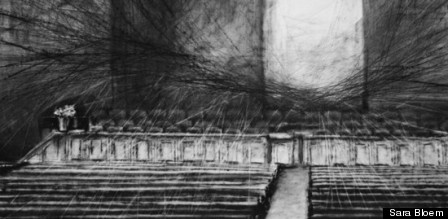Click here to watch the TEDTalk that inspired this post.
When you're an artist, the options that are before you are staggering. Literally anything under the sun is possible. One would think that this kind of freedom would be the perfect scenario in which to be creative. On the contrary, the reality is that for many artists, this sense of freedom is actually quite intimidating. Without any anchor to hold onto, the very early stages of conceiving a project can be the most challenging part of the artistic process.
It sounds like a contradiction, but limitations can actually be quite liberating. Limitations are something concrete to hold on to, when you're just barely treading water, desperately looking for something to land on. Initially, Phil Hansen didn't have a choice with his shaking hand. After learning to embrace his shaking hand, he realized that limitations could actually be an amazing source of inspiration. Seeing the vast range of what he had accomplished with his shaking hand, he began to purposefully self-impose boundaries in his artwork.
It sounds like a contradiction, but limitations can actually be quite liberating. Limitations are something concrete to hold on to, when you're just barely treading water, desperately looking for something to land on. -- Clara Lieu
One of the fundamental concepts that I teach in my freshman drawing classes at the Rhode Island School of Design is how to handle different ranges of artistic freedom. I want my students to develop the skills necessary to be able to foster their artistic vision in the context of the most stringent guidelines, while also understanding how to create work that began with no set requirements.
I assign drawing projects at the beginning of the semester with rigid requirements. One project that I assign early in the semester asks students to make a drawing of an interior architectural space, on a 36" x 48" sheet of paper, using charcoal. With this project, the subject matter has been determined, and the technique is set in stone. Most would assume that these tight restrictions would stunt creativity.
However, many students are pleasantly surprised by the way that these requirements can stimulate creativity and ideas. I give one assignment called "Routine", in which students are asked to create a drawing based on one of their routines. This sounds like a very simple directive, but this assignment has consistently churned out some of the most emotionally involved, complex, and deeply thought provoking drawings of the semester. The drawings created by this prompt are dramatic, hilarious, heart-breaking, and insightful.
Hopelessly addicted to chocolate pudding, one student depicted an exaggerated tower of empty pudding cups while another student visually represented flashbacks of his mother's death from cancer. Other narratives included a student who was forced to attend therapy sessions in high school and rebelled against her parents by stealing "Hello Kitty" paraphernalia from Target, as well as a student who dutifully attended bible study at her church every morning before school for many years, and yet did not believe in her religion.

I intentionally structure my course so that requirements are gradually removed, and eventually, the drawing projects become extremely open ended. Most people would assume that this freedom would be easier than working within stiff guidelines. However, many students comment to me that these projects which require much more self-direction actually causes them to feel lost and aimless. Without any requirements in place, many students find the overwhelming amount of options challenging to manage. This removal of guidelines in the drawing projects can be the most difficult part of my course.
I tell my students that with these new assignments, they now have the responsibility to take charge. I encourage my students to take the initiative to generate their own guidelines. I ask them to create patterns and to reinforce recurring themes in their work. Similar to Phil Hansen's techniques, I've seen students fabricate creative structures for themselves to work within: one student responded by making an entire piece by drawing with a razor blade that had been dipped in black india ink. Another student created a drawing composed only of collaged text messages. I had a student who measured every inch of her childhood house as the basis for her drawing. In this way, these students designed their own structures to work within. Make your own rules, you'll be astonished at what can happen.
Ideas are not set in stone. When exposed to thoughtful people, they morph and adapt into their most potent form. TEDWeekends will highlight some of today's most intriguing ideas and allow them to develop in real time through your voice! Tweet #TEDWeekends to share your perspective or email tedweekends@huffingtonpost.com to learn about future weekend's ideas to contribute as a writer.
